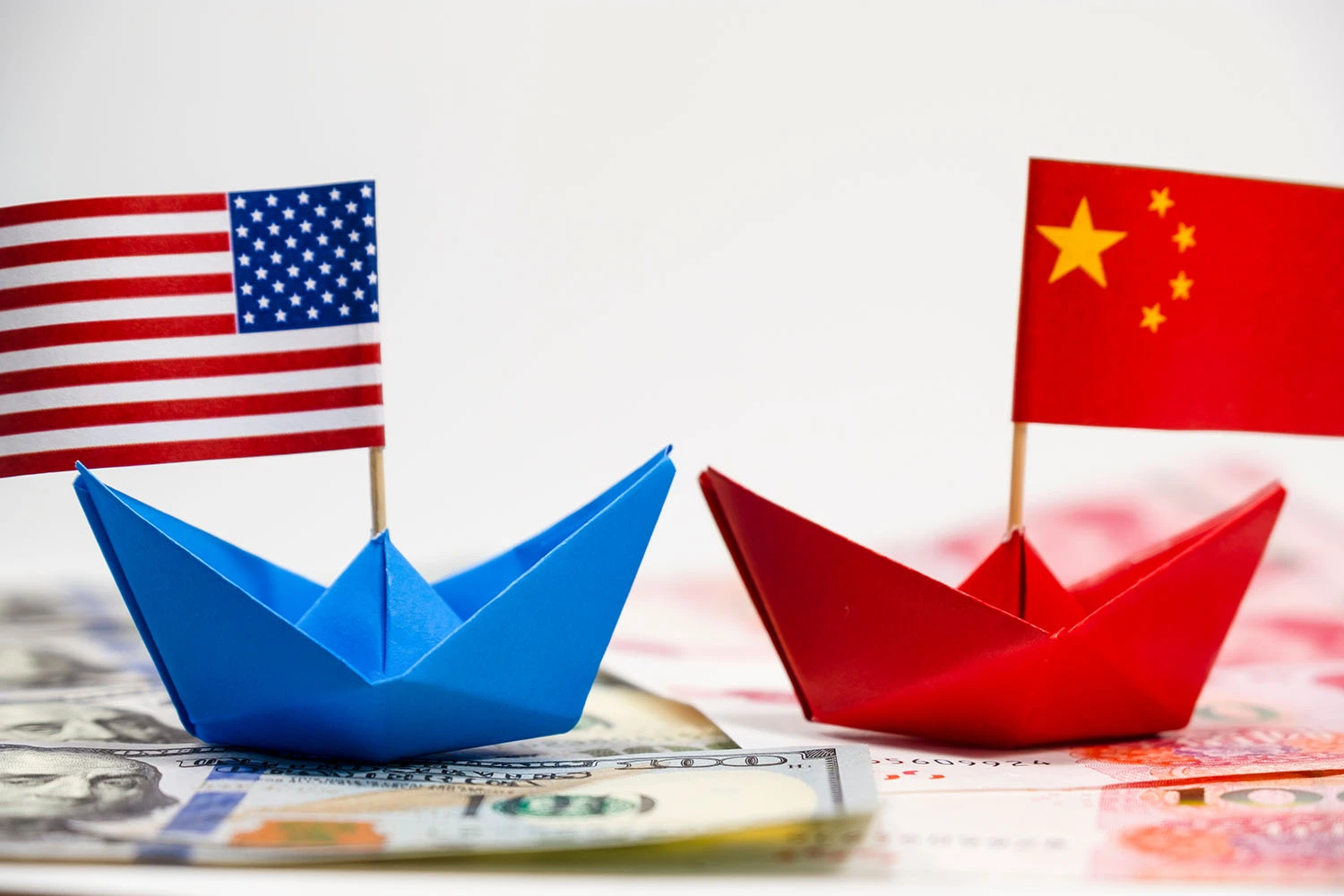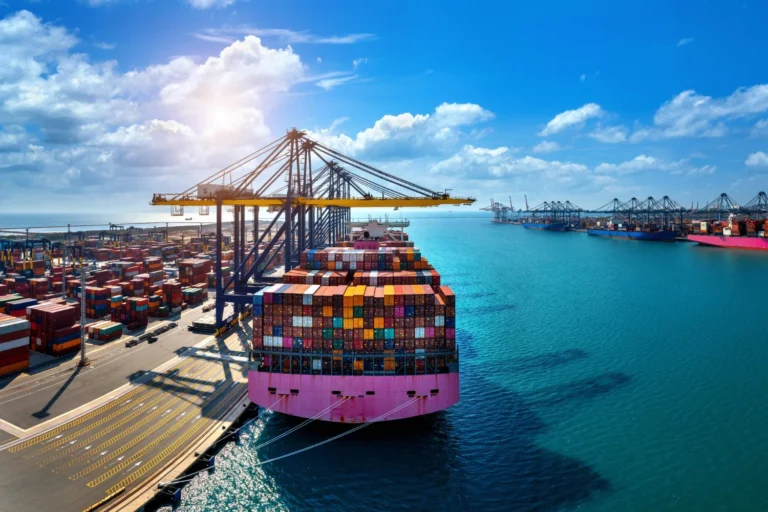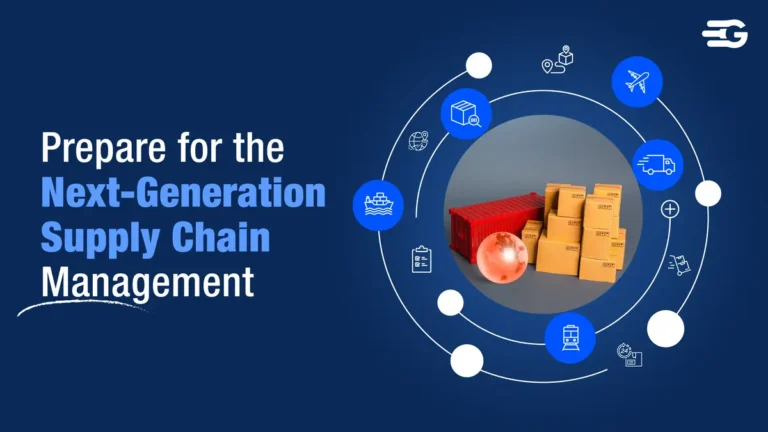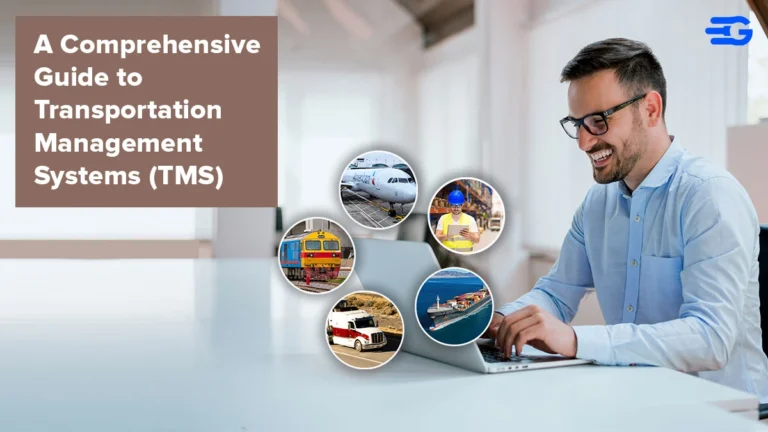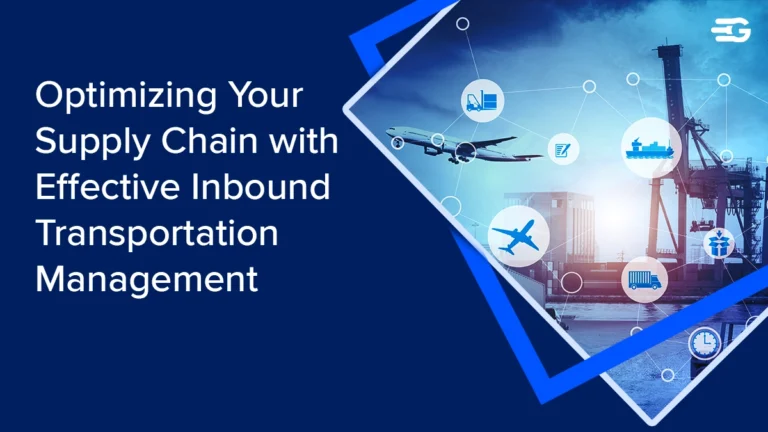Navigating Shipping Costs from China to US: Your Ultimate Guide
Shipping from China to the US can be costly and complicated. As businesses rely on timely deliveries, understanding shipping costs from China to the U.S. is essential for optimizing your logistics strategy.
Whether you’re managing freight for e-commerce, manufacturing, or wholesale distribution, this guide covers the key factors, methods, and costs involved. Get clear insights on how to streamline your shipping process and make better decisions to improve cost efficiency. Let’s break it down.
Shipping Costs from China to the USA
Shipping costs from China to the USA depend on multiple factors such as transport method (air, sea, or express), shipment weight, dimensions, and delivery speed. Here’s a detailed breakdown of typical costs for each method, presented in a table for clarity:
Sea and Ocean Freight Rate Index
Tools like freight shipping rate calculators can streamline your planning. A Gocomet’s Freight Shipping Rates Index Calculator allows you to estimate costs by entering details like shipment origin, destination, and cargo specifics. Gocomet’s Freight Shipping Rates Index Calculator allows users to input shipment details such as origin, destination, and cargo specifics to generate an accurate cost estimate instantly.
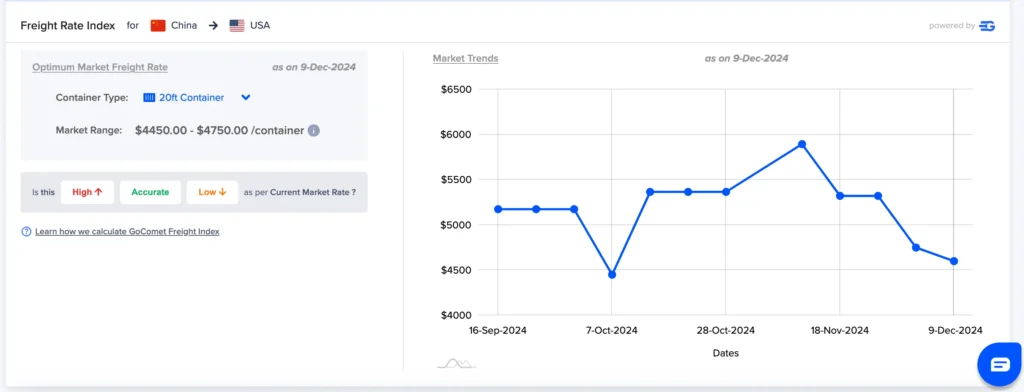
Leveraging such tools not only saves time but also provides insights into market trends, enabling businesses to plan logistics efficiently and stay competitive in a dynamic shipping environment.
Air Freight and Express Shipping Costs
When speed is a priority, Air Freight and Express Shipping are the go-to options for shipments from China to the USA. These methods, while more expensive than sea freight, provide reliable and efficient solutions for urgent or time-sensitive deliveries.
| Shipping Method | Average Cost | Delivery Time | Best For |
| Air Freight | $3.40 to $15.50 per kg | 3–10 days | Urgent shipments |
| Express Shipping | $8–$15 per kg | 5–15 days | Small, time-sensitive loads |
Key Factors Affecting Shipping Costs from China to the US:
- Fuel Prices: Fuel prices significantly impact shipping costs from China to the US. Changes in oil prices can trigger rate adjustments, with shipping companies often applying a Global Fuel Surcharge (GFS) to reflect these shifts.
- Shipping Route: Popular routes like Shanghai to Los Angeles tend to have lower costs due to higher traffic volumes. Less-traveled routes may have higher costs due to lower volume and fewer options.
- Cargo Volume and Size: Larger shipments benefit from volume discounts, reducing per-unit shipping costs. FCL (Full Container Load) shipments are generally more cost-effective than LCL (Less-than-Container Load) due to exclusive use of the container space.
- Customs Clearance Fees: Customs duties and taxes can add significant costs to a shipment. Duties vary based on the product type, but U.S. customs duties average around 5% for most goods, with some items reaching up to 37.5%.
- Seasonal Demand: Shipping costs rise during peak seasons like the Chinese New Year and the U.S. holiday season, when demand for freight services increases, leading to higher prices and limited availability.
- Freight Class & Type of Goods: The nature of the goods impacts the shipping cost. Items like hazardous materials or perishable goods incur higher costs due to special handling and storage requirements.
By understanding these factors, businesses can better anticipate and manage shipping costs from China to the US. Monitoring these variables regularly helps reduce unexpected expenses.: Import duties and taxes can add to shipping costs depending on the goods’ category and value.
Main Shipping Methods from China to the US
Selecting the right shipping method is crucial for balancing cost, speed, and shipment size. Below are the three main options businesses rely on, with unique benefits and trade-offs:
Air Freight from China to the USA:
Air freight is the fastest shipping method, ideal for urgent shipments or high-value goods. Delivery typically takes 3–10 days, making it the top choice for time-sensitive items. However, it comes at a premium cost due to limited cargo space and higher operating expenses. It works best for lightweight shipments or goods where speed justifies the expense.
Downside: Higher costs make it unsuitable for bulk shipments.
Ocean Freight from China to the USA
Ocean freight offers an economical way to transport large volumes of goods. It’s slower, taking 20–45 days, but is cost-effective for bulky or non-urgent shipments. Businesses can choose between:
- Full Container Load (FCL): Ideal for large shipments requiring an entire container.
- Less than Container Load (LCL): Cost-efficient for smaller shipments sharing container space.
Downside: Longer transit times and potential delays at customs.
Key Ports in China and USA
The major ports in China and the United States are critical in determining the overall shipping cost and transit time. In China, ports like Shanghai, Shenzhen, and Ningbo handle the highest volume of goods. These are some of the busiest and most efficient shipping hubs globally.
In the United States, ports such as Los Angeles, Long Beach, and New York dominate the trans-Pacific shipping lanes.
Shipping from these major ports typically incurs lower costs due to their high volume, but port congestion can lead to delays and higher fees. Proximity to these ports can also influence transit times and the types of goods being shipped. For instance, goods shipped from ports in the north of China, such as Tianjin, may take slightly longer to reach the U.S. compared to southern ports like Shenzhen.
Understanding Port Selection for Cost Efficiency
Selecting the right ports plays a significant role in balancing costs and delivery times. Major ports like Shanghai, Shenzhen, and Ningbo in China, and Los Angeles, Long Beach, and New York in the US, handle high cargo volumes, often making them cost-effective options.
Understanding Port Selection for Cost Efficiency
Choosing the right ports is crucial for balancing costs and delivery times. Major ports like Shanghai, Shenzhen, and Ningbo in China, and Los Angeles, Long Beach, and New York in the US, handle large volumes of cargo, making them cost-effective options.
However, port congestion can lead to delays and higher fees. For example, a potential strike at US East Coast ports could disrupt operations, causing further delays and cost increases. Retailers are urging for talks to avoid such strikes, which could significantly impact supply chains. Tools like real-time port congestion data can help businesses monitor conditions and adjust their port selection to avoid delays.
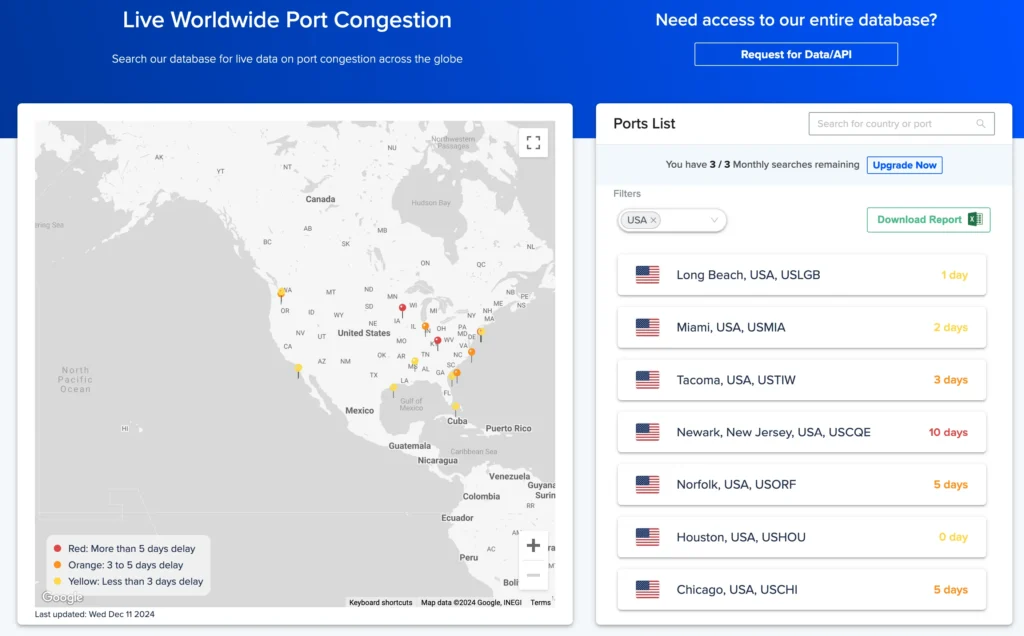
By incorporating live data into planning, businesses can improve shipping efficiency and keep costs predictable.
3. Express Shipping:
Express shipping provides door-to-door service, combining the speed of air freight with logistical convenience. It’s typically delivered within 5–15 days. Express services handle all customs and delivery processes, making them highly reliable for businesses that need simplicity and speed without managing freight complexities.
Downside: More expensive than sea freight for the same weight, but cheaper than traditional air freight.
Choosing Between Air Freight vs Ocean Freight
Choosing the right shipping method between air freight and ocean freight depends on several factors, including cost, speed, shipment size, and reliability. Here’s a comparison of the two methods:
| Factor | Air Freight | Ocean Freight |
| Speed | 3-10 days (faster) | 20-45 days (slower) |
| Cost | Higher (5-10 times more expensive) | Lower (more cost-effective for bulk) |
| Shipment Size | Ideal for small, high-value goods | Best for large, bulk shipments |
| Reliability | Highly reliable with fewer delays | Can experience delays due to weather or port congestion |
| Environmental Impact | Higher carbon footprint | Lower emissions per ton-mile |
| Customs & Import Restrictions | Stricter inspections | More lenient customs procedures |
Import Tax and Duties
When shipping from China to the US, import taxes and duties can significantly affect total shipping costs. These fees depend on the product type, declared value, and destination state. Businesses must understand how these charges are calculated to avoid surprises.
Key Factors Influencing Import Taxes and Duties
- Product Classification: Every product is assigned a Harmonized Tariff Schedule (HTS) code. This code determines the applicable duty rate based on the type of goods. For example, electronics and textiles have different duty rates.
- Declared Value: The customs authority calculates duties based on the total value of goods, including the cost of the product, shipping charges, and insurance. Undervaluing shipments may lead to penalties.
- Country of Origin: Goods originating from certain countries may qualify for lower duties or exemptions under trade agreements.
- Additional Fees: Customs clearance might involve processing fees, inspection charges, and port fees, depending on the shipment type and customs authority’s evaluation.
Example of Duty Calculation
Let’s assume a business imports $50,000 worth of textiles to California
| Category | Value (USD) | Details |
| Product Cost | $50,000 | Declared value of goods. |
| Duty Rate (12%) | $6,000 | Based on textile classification. |
| Customs Processing Fee | $485 | Fixed fee for entry processing. |
| Total Import Costs | $6,485 | Duties + Fees. |
Tools to Simplify Duty Calculations
Businesses can estimate import taxes using tools like:
- Harmonized Tariff Schedule (HTS): Helps classify products and find the duty rate.
- Customs Brokers or Freight Forwarders: Experts who ensure accurate classifications and smooth customs clearance.
By planning for these costs and working with experienced logistics partners, businesses can avoid delays and keep budgets on track.
Express Shipping from China to the USA
Express shipping combines speed and affordability. It delivers goods faster than sea freight and costs less than air freight. Delivery takes 5–15 days, making it a great middle-ground option.
Costs range between $8–$15 per kg, depending on the service provider. Businesses shipping small, time-sensitive items often prefer express shipping.
Shipping Cost Calculator: Picking the Best Method
Using a shipping cost calculator makes estimating costs simple and efficient. By inputting shipment details like weight, dimensions, and destination, businesses can receive accurate cost estimates instantly. This helps in choosing options that align with both timelines and budgets.
When deciding on a shipping method, consider these factors:
- Budget: Match shipping speed with cost-effectiveness.
- Urgency: Select air or express shipping for fast delivery.
- Size: Use ocean freight for larger shipments.
There are many such amazing tools online, making them accessible for businesses aiming to streamline logistics planning.
Conclusion
Shipping from China to the US requires understanding your options, costs, and priorities. Whether it’s air freight, sea freight, or express shipping, there’s a solution for every business need. Carefully plan and use tools like a cost calculator to optimize your shipping strategy.
FAQs
How Long Does Sea Freight Take from China to the US?
Sea freight transit times vary based on the specific ports and shipping routes used. On average, it can take between 20 to 35 days for a container to reach the US from China. This depends on whether you are shipping to the West Coast (faster) or the East Coast (longer). Shipping to ports like Los Angeles typically takes around 15 to 25 days, while ports on the East Coast, like New York or Savannah, might take 30 to 35 days. Delays due to port congestion, customs procedures, or weather conditions can extend these times.
How Much Does a Container from China to the US Cost?
The cost of shipping a Full Container Load (FCL) from China to the US varies depending on the shipping season, demand, and fuel prices. As of recent reports, the typical price range for FCL from China to the US is between $2,500 to $6,000 per container. These rates can be significantly higher during peak seasons, such as the holiday shipping rush, or if the container requires special handling. Always check current rates from reliable freight providers like Maersk, CMA CGM, or COSCO for more accurate pricing at the time of shipment.
How Much Does LCL from China to the US Cost?
Less than Container Load (LCL) shipping generally costs $150 to $250 per cubic meter depending on the cargo’s characteristics and the season. In addition to base rates, additional charges like port fees, terminal handling charges (THC), and customs fees might apply. LCL can be a more cost-effective option for smaller shipments that don’t require a full container but do involve more handling and longer transit times.
What are the Best Sea Freight Companies in China?
Some of the most reliable and well-established freight companies for shipping from China to the US include:
- Maersk Line: Known for its global network and extensive service offerings.
- CMA CGM: Offers a range of solutions, including direct and feeder services.
- COSCO: One of the largest shipping companies in China, renowned for its competitive pricing and reliable services. Other notable players include Hapag-Lloyd and Evergreen. These companies offer both FCL and LCL services and have a track record for reliability and efficiency.
How to Ship from China to the US?
Shipping from China to the US requires a few critical steps:
- Choose the right shipping method (Air Freight, Ocean Freight, LCL, FCL).
- Work with a reputable freight forwarder who will help you navigate customs regulations and documentation.
- Ensure all documentation is in order, including the Bill of Lading, Commercial Invoice, and Packing List.
- If shipping by ocean, consider your port options; West Coast ports are typically faster, but East Coast ports can be more cost-effective depending on your location.
- Once your cargo arrives, your freight forwarder will help with customs clearance before it reaches its final destination.
For more specific and up-to-date shipping rates, it’s advisable to contact freight forwarders or use tools such as GoComet’s Freight Calculator to get precise quotes.
